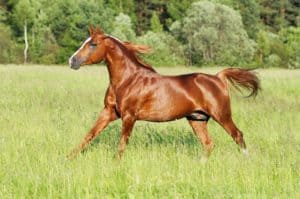‘Scratches’-Afflicted Skin Has Microbiota Upset, More Staph

In the study, bacteria on EPD skin were much less diverse and had a different order of species abundance than skin bacteria on the non-EPD pasterns of the same horse, said Sarah Kaiser-Thom, DVM, PhD, of the Swiss Institute of Equine Medicine (ISME) at the University of Bern, and Agroscope, in Switzerland.
In particular, Staphylococcaceae species were much more prominent in the EPD pasterns, and three other families—Sphingomonadaceae, Burkholderiaceae, and Microbacteriaceae—were significantly less prevalent, suggesting Staphylococcus might have been outcompeting these other species and making it more difficult for them to thrive, Kaiser-Thom said.
Veterinarians and owners alike have long suspected bacteria might have at least an exacerbating role in EPD—a complex condition that could have multiple underlying causes. But scientists had yet to link the syndrome to specific bacteria.
“That might be why EPD falls into the category of medical conditions where antibiotic treatment is very much used in clinical practice, although we do not really know what is going on,” said Kaiser-Thom.
So she and her fellow researchers ran genome sequencing on skin samples from 80 horses with any of the three recognized forms of EPD: mild, exudative, and proliferative. They also took samples from at least one other pastern, free of EPD, from the same horse for comparison.
Where lesions were visible, they found the variety of bacterial species was less diverse and that the microbiota had “significant disordering”—meaning the order of abundance (from most to least abundant species of bacteria) differed from that of the healthy legs.
These changes were greater in more severe cases and in the more severe forms—exudative and proliferative—compared to milder cases and forms, Kaiser-Thom said.
The alterations were “exceptionally pronounced” in cases that had previously been treated with antibiotic therapy (hinting at antimicrobial resistance’s possible role in scratches), especially regarding the abundance of Staphylococcaceae, she said.
That doesn’t mean staphylococcus causes scratches, Kaiser-Thom warned. “We really can’t conclude that any bacteria cause EPD,” she said. “At this point we can only show that it’s associated with it.”
While the trends they noted open doors for further research—two more studies are in progress—the findings are still “basic,” said Kaiser-Thom.
“EPD is common, and people have this empirical knowledge about it, like it always happens in autumn or it’s always when it’s wet and muddy, and we should put different kinds of creams on it,” Kaiser-Thom said. “But overall, up until now we really haven’t known much—scientifically—about EPD. So this study is the first to really describe what’s happening in the bacterial populations in cases of EPD.”
Until scientists learn more, owners can continue to treat scratches carefully with conservative methods such as shaving hair from the affected area, keeping it clean, and using antimicrobial treatments with caution, she said.
The study, “The skin microbiota in equine pastern dermatitis: a case-control study of horses in Switzerland,” was published April 8, 2021, by Veterinary Dermatology.

Written by:
Christa Lesté-Lasserre, MA
Related Articles
Stay on top of the most recent Horse Health news with












